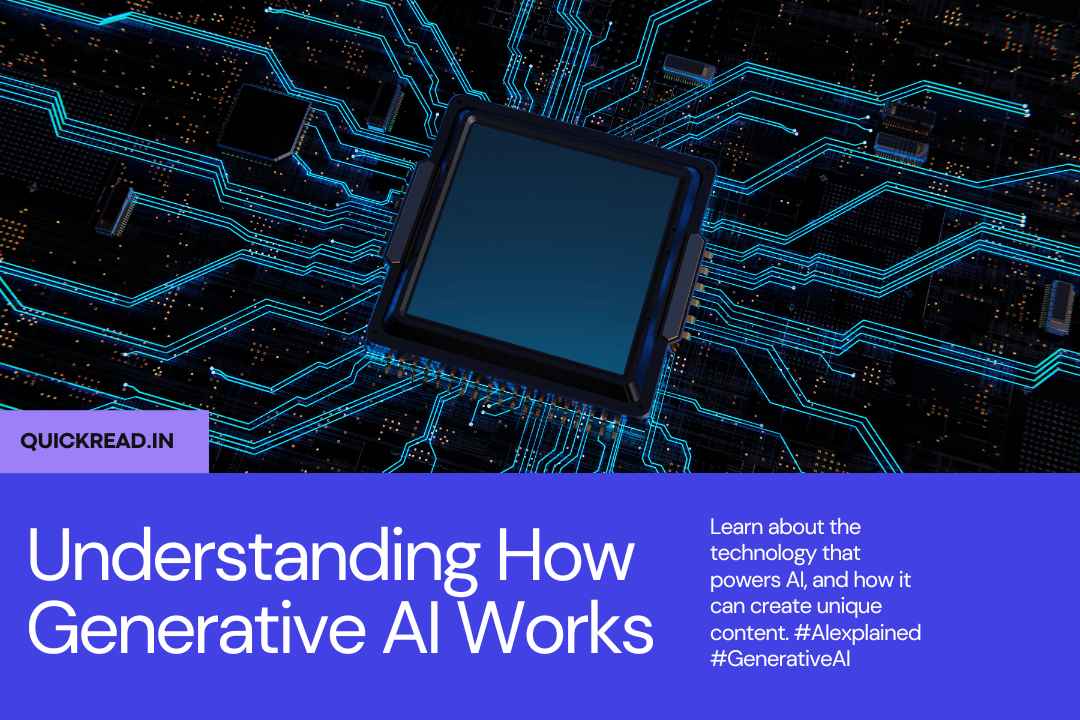Introduction
The rise of large language models like GPT-3 has enabled a new class of generative AI that can produce remarkably human-like text, images, audio, code and more. But how do models like DALL-E 2 and Stable Diffusion actually work behind the scenes?
In this comprehensive guide, we’ll dig into the technical foundations powering modern how generative AI works:
- The shift from predictive to generative models
- Using autoencoders and GANs for generation
- Transformers and large language models
- Decoder-only architectures
- Text-to-image generation
- How diffusion models work
- Evaluating and detecting synthetic content
- The ethics of generative models
By the end, you’ll have an in-depth understanding of how models like DALL-E and Stable Diffusion generate artificial but increasingly realistic outputs. Let’s get started!
Understand How Generative AI Works
From Predictive to Generative Models
Much of traditional machine learning focuses on predictive models like classifiers and regressors that map inputs to outputs. For example:
- Classifying an image as a cat or dog
- Predicting house prices from attributes
Generative models flip this by learning to produce entirely new samples that imitate a training dataset. Some examples:
- Generating novel images that look real but aren’t
- Synthesizing text that reads fluently
- Creating sound samples that resemble a style or musician
This allows AI systems to exhibit creativity and imagination!
Two key techniques for building generative models are variational autoencoders and generative adversarial networks.
Variational Autoencoders
Autoencoders consist of two neural networks – an encoder and decoder.
The encoder compresses input data into a low-dimensional latent space representation. The decoder then reconstructs the input from the compressed latent space.
By training to minimize reconstructing loss, autoencoders learn efficient latent features.
Variational autoencoders improve on basic autoencoders by generating probabilistic representations. This converts inputs into a distribution over possible outputs.
Sampling from this distribution yields novel generated instances!
Generative Adversarial Networks
A GAN consists of two components – a generator model and discriminator model.
The generator takes randomized input and produces artificial outputs meant to match the training data. For example, generating artificial images.
The discriminator tries to detect whether examples are real from the training data or artificially produced by the generator.
The two models train in a adversarial loop – the generator tries to maximize generating realistic outputs while the discriminator tries to get better at detecting its counterfeits.
This adversarial dynamic causes the generator to improve continuously. GANs can produce remarkably convincing generated samples.
Large Language Models and Transformers
For generative text, Transformer-based language models like GPT-3 are state-of-the-art.
Transformers process text by passing it through layers of attention mechanisms rather than RNNs.
This allows modeling long range dependencies in text efficiently.
Trained on massive text corpora, these huge neural networks learn powerful language representations that can generate human-like text.
Let’s look at one popular transformer architecture called the decoder-only transformer next.
Decoder-Only Transformers
Most transformer-based language models use an encoder-decoder architecture.
But models like GPT-3 and DALL-E use a simpler decoder-only architecture.
Rather than encoding source data to context vectors, the input sequence is directly fed into the transformer decoder blocks.
The decoder self-attends to previously generated tokens to model long term dependencies.
This sequential generation process creates coherent, locally sensible text and image descriptions.
Combined with massive scale, this architecture produces remarkably capable generative models.
Text-to-Image Generation
Advances in text-to-image generation have powered applications like DALL-E and Stable Diffusion.
The models first condense text descriptions into fixed size input vectors.
These semantic vectors are decoded into realistic images that match the text description.
Understanding language/vision relationships is key to generating plausible images from text captions.
Researchers have found training text-to-image models to synthesize and discriminate fakes improves generation capabilities.
This shows techniques like GANs and transformers compliment each other in building generative systems.
Diffusion Models
Diffusion models have become a leading approach for image generation.
The diffusion process gradually adds noise to an image over repeated steps while recording the noise levels.
The model is trained to take a noise-corrupted image and perform reverse diffusion to restore the original image by removing noise.
To generate images, random noise is fed into the reverse diffusion process.
Controlling noise levels and sequences allows creating diverse realistic images from scratch.
DeepMind and Anthropic have open sourced diffusion image generation models.
Evaluating and Detecting Synthetic Content
As generative models improve in sophistication, detecting artificial generated content is becoming critical:
- Human evaluation – Large sample human classification of real vs fake still provides the best benchmark. But subjective and costly.
- In-the-loop training – Train models to detect their own generated samples from real data. Use adversary techniques like GANs.
- Analyzing model fingerprints – Detect patterns like repeated objects that human creations lack.
- Multimodal inconsistencies – Compare alignments between modalities like image + text that humans naturally follow.
Robust synthetic content detection remains an open research problem as generation techniques evolve.
The Ethics of Generative Models
The rise of highly capable generative models comes with many ethical concerns to consider:
- Potential to spread mis/disinformation at scale
- Biases perpetuated through training data
- Misuse for scams, spoofing identities
- Intellectual property and copyright issues
- Harmful or abusive content generation
Maintaining humanity’s role in directing technology ethically is crucial as AI capabilities grow more powerful in coming years.
Conclusion
This guide provided a comprehensive look at modern techniques powering generative AI like large language models, GANs, transformers and diffusion models.
Key takeaways include:
- Autoencoders and GANs provide early generative breakthroughs
- Decoder-only transformers generate coherent text and image descriptions
- Diffusion models create realistic images from noise
- Capabilities like text-to-image generation demonstrate understanding across domains
- Detecting fake generated content remains challenging
The stunning outputs of systems like DALL-E and Stable Diffusion showcase the rapid progress in generative modeling. But ethical guidance will remain imperative as the technology continues evolving.
I hope this piece leaves you with deeper insight into the technical innovations behind this fast-moving field and the responsibilities we have in steering it wisely. Let me know if you have any other questions!
Frequently Asked Questions
Q: How is generative modeling different from traditional machine learning?
A: Generative modeling focuses on creating completely new samples rather than predicting outputs from inputs. This requires learning deep representations from training data.
Q: What are some examples of generative AI models?
A: Popular examples include large language models like GPT-3 for text generation and DALL-E 2, Stable Diffusion for image generation. WaveNet generates audio samples.
Q: How do techniques like GANs and autoencoders enable generation?
A: GANs train models to generate increasingly realistic outputs. Autoencoders learn compressed representations that can be sampled from to generate new data.
Q: Why are transformer models like GPT-3 so effective for text generation?
A: Self-attention allows transformers to model very long range dependencies in text sequences, enabling coherent generated text.
Q: What are possible negative societal impacts of advanced generative models?
A: Potential for misinformation, perpetuating biases, identity spoofing, intellectual property issues, and generating harmful content.
Q: How can we detect artificially generated text, images and audio?
A: Analyzing statistical patterns, fingerprints, and inconsistencies. Comparing human evaluations. Training models to detect their own generations.
Q: Are there benevolent applications of generative models?
A: Absolutely – creative applications and augmenting human capabilities with properly directed AI alignment. But ethical risks must be addressed.


